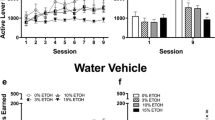Abstract
Eight male squirrel monkeys were trained to use the pharmacological effects of ethanol [orally via gastric intubation 1600 mg/kg (IG), in normal saline] versus those produced by equivolume saline as discriminative stimuli in an operant conditioning (bar pressing) procedure in which the availability of banana-flavored food pellets was made contingent upon the drug condition of the animal (ethanol SD, saline SΔ for four monkeys; saline SD, ethanol SΔ for the other four monkeys). Test doses of 7.5 mg/kg pentobarbital IG and 80 mg/kg barbital IG closely mimicked the cue properties of ethanol, while doses of morphine sulfate (5.0–20 mg/kg IG) failed to elicit ethanol-appropriate responding. Other ethanolic beverages containing 1600 mg/kg ethanol in the same volume as the training dose, and found to mimic the cue properties of pure ethanol were bourbon, gin, beer, vodka, and red wine. The single test dose of cognac, scotch, and tequila clicited responding different from that of the training dose of ethanol. Thus, the pharmacological effects of ethanolic beverages containing the same dose of ethanol (1600 mg/kg) may be noticeably different to some subjects. Blood levels of ethanol produced by the different beverages may be an important variable. There was no differential effect of the beverages upon free-feeding behavior of the monkeys at the time of testing. Ethanol preference tests conducted at the end of the study (i.e., after nearly 2 years of drug discrimination training) indicated that the assignment of ethanol as the condition under which food pellets were available (SD condition) moderately increased the ethanol preference of those subjects as compared to monkeys for whom ethanol had served as the SΔ condition.
Similar content being viewed by others
References
Ashe JH, Nachman (1980) Neural mechanisms in taste aversion learning. In: Sprague JM, Epstein AN (eds) Progress in psychobiology and physiological psychology. Academic, New York, pp 233–261
Auty RM, Branch RA (1977) Pharmacokinetics and pharmacodynamics of ethanol, wiskey, and ethanol with n-propyl, n-butyl and iso-amyl alcohols. Clin Pharmacol Ther 22:242–249
Barry III H, Krimmer EC (1977) Discriminable stimuli produced by alcohol and other CNS depressants. In: Lal H (ed) Discriminative stimulus properties of drugs. Plenum, New York, pp 73–92
Blum K, Ryback RS, Geller I (1972) Effects of vodka and bourbon on lever-pressing behavior of mice. Curr Ther Res 14:95–98
Brusch CA, Cerrato CM, Papas PN, Straccia FA (1955) Clinical and laboratory evaluation of alcoholic beverages. Am J Protocol 6:140–144
Carroll RB (1970) Analysis of alcoholic beverages by gas-liquid chromatography. Q J Stud Alcohol (Suppl) 5:6–19
Colpaert FL, Rosecrans JA (eds) (1978) Stimulus properties of drugs: Ten years of progress. Amsterdam, Elsevier-North Holland Biomedical
Damrau F, Liddy E (1960) The whisky congeners: Comparison of whisky with vodka as to toxic effects. Curr Ther Res 2:453–457
Dussault P, Burford R, Chappel C (1973) Studies of alcohol beverages physiological effects. Bio Research Laboratories, Pointe Claire
Garcia J, Rusiniak KW, Brett LP (1977) Conditioning food-illness aversions in wild animals: Caveant canonici. In: Davis H, Hurwitz H (eds) Operant-Pavlovian interactions. Wiley, New York, pp 273–316
Goldberg L (1961) Alcohol, tranquilizers and hanover. Q J Stud Alcohol (Suppl) 1:37–55
Haggard HW, Greenberg LA, Cohen LH (1943) The influence of the congeners of distilled spirits upon the physiological action of alcohol. Q J Stud Alcohol 4:3–56
Ho BT, Richards III DW, Chute DL (eds) (1978) Drug discrimination and state-dependent learning. Academic, New York
Kalant H, Le Blanc AE, Wilson A, Homatidis S (1975) Sensorimotor and physiological effects of various alcoholic beverages. Can Med Assoc J 112:953–958
Kimble GA (1968) Hilgard and Marquis' conditioning and learning. Appleton Century Crofts, New York
Lal H (ed) (1977) Discriminative stimulus properties of drugs. Plenum, New York
Leake U, Silverman M (1971) The chemistry of alcoholic beverages. In: Kissin B, Begleiter H (eds) The biology of alcoholism, vol 1. Plenum, New York, pp 575–612
Logue AW (1979) Taste aversion and the generality of the laws of learning. Psychol Bull 86:276–296
Murphree HB (1971) The importance of congeners in the effects of alcoholic beverages. In: Israel Y, Mardones J (eds) Biological basis of alcoholism. Wiley Interscience, New York, pp 209–234
Pikkanen TA (1957) On static atactic functional disorders caused by alcohol: A Comparative study of different beverages. Q J Stud Alcohol 18:183–189
Revusky S, Parker LA, Coombes J, Coombes S (1976) Rat data which suggest alcoholic beverages should be swallowed during chemical aversion therapy, not just tasted. Behav Res Ther 14:189–194
Schaefer GJ, Holtzman SG (1977) Discriminative effects of morphine in the squirrel monkey. J Pharmacol Exp Ther 201:67–75
Schaefer GJ, Holtzman SG (1978) Discriminative effects of cyclazocine in the squirrel monkey. J Pharmacol Exp Ther 205:291–301
Snell CA (1958) The congener content of alcoholic beverages. Q J Stud Alcohol 19:69–71
Wagner AR (1969) Frustrative nonreward: A variety of punishment. In: Campell BA, Church RM (eds) Punishment and aversive behavior. Appleton Century Crofts, New York, pp 157–184
York JL (1978b) A comparison of the discriminative stimulus effects of ethanol, barbital, and phenobarbital in rats. Psychopharmacology 60:19–23
York JL (1978a) Role of secondary reinforcing properties of ethanol in the acquisition of ethanol preference in rats. Clin Exp Res 2:219
York JL (1982) Body water content, ethanol pharmacokinetics, and the responsiveness to ethanol in young and old rats. Dev Pharmacol Ther (in press)
York JL, Winter JC (1975) Long-term effects of barbital on spontaneous activity of rats trained to use the drug as a discriminative stimulus. Psychopharmacologia 42:47–50
Author information
Authors and Affiliations
Rights and permissions
About this article
Cite this article
York, J.L., Bush, R. Studies on the discriminative stimulus properties of ethanol in squirrel monkeys. Psychopharmacology 77, 212–216 (1982). https://doi.org/10.1007/BF00464568
Received:
Accepted:
Issue Date:
DOI: https://doi.org/10.1007/BF00464568




